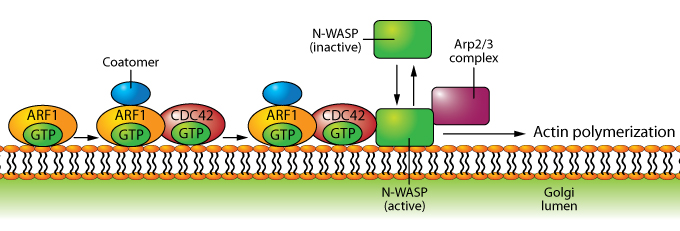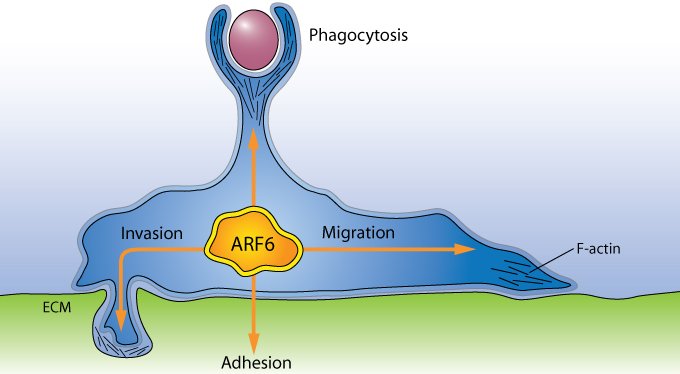About ADP-ribosylation factor (Arf) small G-proteins
The mammalian ADP-ribosylation factor (Arf) family of the Ras superfamily of GTPases consists of six Arf isoforms (Arf1-Arf6). The Arf GTPases were originally named for their ability to stimulate cholera toxin-mediated ADP ribosylation of the Gsα subunit utilized by many G-protein coupled receptors1. These GTPases are grouped into three classes based on their size and amino acid similarity: class I (Arf1, Arf2, Arf3), class II (Arf4 and Arf5), and class III (Arf6)2. Arf2 is not found in humans, while Arf1 and Arf6 are the focus of most Arf research efforts. Arf1 and Arf6 have distinct but similar functions in protein and membrane vesicle trafficking in the cell2,3, with roles in endosome and vesicle fusion as well as clathrin-mediated endocytosis.
Role of Arf1 in regulating actin assembly during vesicle formation at the Golgi.

Historically, Arf1 has been viewed as having a primary role in the development and maturation of coated vesicles that transport proteins from the endoplasmic reticulum to the Golgi apparatus (see Arf1 figure), but recent data have also implicated Arf1 in the transport of proteins from the Golgi membrane to the plasma membrane4, as well as phagocytosis5. Arf6 is localized at the plasma membrane and endocytic compartments where the protein plays a significant role in endocytic membrane trafficking and localized actin dynamics, the latter involving cross-talk with Rho family GTPases3 (see Arf6 figure).
Roles for Arf6 at the cell periphery involving membrane trafficking and actin cytoskeletal re-organization.

Like other small G-proteins, Arf GTPases cycle between the inactive GDP-bound and the active GTP-bound states. The cycling between GTP/GDP is modulated by the activities of several guanine nucleotide exchange factors (GEFs; e.g., ARNO) and guanine nucleotide activating proteins (GAPs). The Arf GEFs mediate the activation of Arfs through the exchange of bound GDP for GTP while the Arf GAPs inactivate the Arfs by bolstering the low intrinsic GTPase activity of the small G-proteins. Several GEFs have been identified for the Arf small G-proteins and each GEF harbors a 200 amino acid Sec7 domain that has been shown to be sufficient for the GEF activity6. These GEFs vary greatly in overall size and have classically been categorized by their sensitivity or resistance to inhibition by the fungal antibiotic Brefeldin A (BFA), and more recently through phylogenetic analyses7,8. Arf1 is known to be activated by GEFs that fall into both categories with respect to BFA sensitivity, whereas Arf6 appears to be exclusively activated by BFA resistant GEFs3. One BFA resistant GEF that interacts with both Arf1 and Arf6 is ARNO (a.k.a. cytohesin-2)9-12. Cell-free biochemical assays demonstrated that ARNO can activate both Arf1 and Arf69 and ARNO can also activate both Arf isoforms when exogenously expressed in cells10-12. Further study of ARNO and Arf1 and Arf6 has clarified the relationship between the GEF and these GTPases. ARNO exhibits clear substrate preference for Arf1 and is an accepted GEF for this GTPase. Conversely, ARNO interacts with Arf6 mainly as an effector, as GTP-bound Arf6 recruits the GEF to the plasma membrane12, leading to activation of Arf1. ARNO may also act as a weak Arf6 GEF10-12.
ARNO-induced Arf Activation.

Figure Legend: Example provided by Dr. Lorraine Santy (Penn State University) of Arf activation by ARNO in MDCK cells infected with control adenovirus (left panel) or adenovirus encoding myc-tagged E156K mutant (middle panel) or wild-type (right panel) ARNO protein. ARNO proteins localized with a 9e10 anti-myc primary antibody and CY2-conjugated secondary antibody (green). F-actin labeled with rhodamine-phalloidin (red). Cells expressing wild-type ARNO protein have robust lamellipodia (right panel, arrows), whereas cells expressing the catalytically inactive mutant ARNO (middle panel) fail to form these cell protrusions. Scale bar = 50 microns. Note: Rhodamine-phalloidin (Cat. # PHDR1) is available from Cytoskeleton, Inc.
Although Arf1 and Arf6 reside primarily in different subcellular locations, they accomplish similar tasks when activated. Both Arf1 and Arf6 are known to activate lipid modifying enzymes that can alter local membrane environments3. Changes in the actin cytoskeleton also occur in the vicinity of these membrane micro-environments through Arf1 and Arf6-mediated activation of the Rho family GTPases Cdc42 and Rac, respectively13. Golgi-associated active Arf1 recruits Cdc42 to coat protein complex I (COPI) on developing Golgi vesicles where it activates N-WASP, leading to activation of the Arp2/3 complex and actin polymerization14 (see Arf1 figure). The resulting changes in the local actin cytoskeleton are thought to facilitate Golgi vesicle maturation. At the plasma membrane, Arf6 utilizes Rac to modulate the local actin cytoskeleton in a variety of processes that include phagocytosis/endocytosis, cell adhesion, migration, and invasion3 (see Arf6 figure). Rac activation via Arf6 is mediated primarily through the recruitment of the Rac GEFs Dock180 (Dock180-ELMO complex), Kalirin5, and Trio15,16.
Available Arf Products
- Arf1 G-LISA Activation Assay Biochem Kit (Cat. # BK132)
- Arf1 Activation Assay Biochem Kit (Pull-down format) (Cat. # BK032-S)
- Arf6 G-LISA Activation Assay Biochem Kit (Cat. # BK133)
- Arf6 Activation Assay Biochem Kit (Pull-down format) (Cat. # BK033-S)
- GGA3-PBD Beads (Cat. # GGA05)
References
- Kahn R.A. and Gilman A.G. (1986). The protein cofactor necessary for ADP-ribosylation of Gs by cholera toxin is itself a GTP binding protein. J. Biol. Chem. 261, 7906-7911.
- Tsuchiya M., Price S.R., Tsai S.C., Moss J., and Vaughan M. (1991). Molecular identification of ADP-ribosylation factor mRNAs and their expression in mammalian cells. J. Biol. Chem. 266, 2772-2777.
- D’Souza-Schorey C. and Chavrier P. (2006). Arf proteins: roles in membrane traffic and beyond. Nat. Rev. Mol. Cell Biol. 7, 347- 358.
- Dong C., Zhang X., Zhou F., Dou H., Duvernay M.T., Zhang P., and Wu G. (2010). ADP-ribosylation factors modulate the cell surface transport of G-protein-coupled receptors. J. Phamacol. Exp. Ther. 333, 174-183.
- Beemiller P., Hoppe A.D., and Swanson J.A. (2006). A phosphatidylinositol-3-kinase-dependent signal transition regulates Arf1 and Arf6 during Fcγ receptor-mediated phagocytosis. PLoS Biol. 4: e162.
- Chardin P., Paris S., Antonny B., Robineau S., Beraud-Dufour S., Jackson C.L., and Chabre M. (1996). A human exchange factor for Arf contains Sec7- and pleckstrin-homology domains. Nature. 384, 481-484.
- Cox R., Mason-Gamer R.J., Jackson C.L., and Segev N. (2004). Phylogenetic analysis of Sec7-domain-containing Arf nucleotide exchangers. Mol. Biol. Cell. 15, 1487-1505.
- Jackson C.L. and Casanova J.E. (2000). Turning on ARF: the Sec7 family of guanine-nucleotide-exchange factors. Trends Cell Biol. 10, 60-67.
- Macia E., Chabre M. and Franco M. (2001). Specificities for the small G proteins Arf1 and Arf6 of the guanine nucleotide exchange factors ARNO and EFA6. J. Biol. Chem. 276, 24925-24930.
- Frank S., Upender S., Hansen S.H., and Casanova J.E. (1998). ARNO is a guanine nucleotide exchange factor for ADP-ribosylation factor 6. J. Biol. Chem. 273, 23-27.
- Santy L.C. and Casanova J. E. (2001). Activation of Arf6 by ARNO stimulates epithelial cell migration through downstream activation of both Rac1 and phospholipase D. J. Cell Biol. 154, 599-610.
- Cohen L.A., Honda A., Varnai, P., Brown F.D., Balla T., and Donaldson J.G. (2007). Active Arf6 recruits ARNO/Cytohesin GEFs to the PM by binding their PH domains. Mol. Biol. Cell. 18, 2244-2253.
- Myers K.R. and Casanova J. E. (2008). Regulation of actin cytoskeleton dynamics by Arf-family GTPases. Trends Cell Biol. 18, 184-192.
- Heuvingh J., Franco M., Chavrier P, and Sykes C. (2007). Arf1-mediated actin polymerization produces movement of artificial vesicles. Proc. Natl. Acad. Sci. U.S.A. 104, 16928-16933.
- Santy L.C., Ravichandran K.S., and Casanova J.E. (2005). The DOCK180/Elmo complex couples ARNO-mediated Arf6 activation to the downstream activation of Rac1. Curr. Biol. 15, 1749-1754.
- Koo T.H., Eipper B.A., and Donaldson J.G. (2007). Arf6 recruits the Rac GEF Kalirin to the plasma membrane facilitating Rac activation. BMC Cell Biol. 8, 29.
